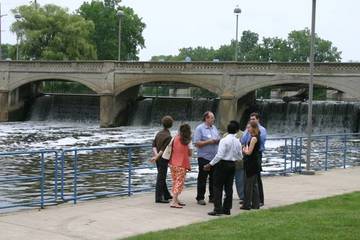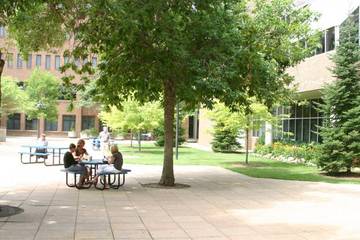A biweekly newsletter with public space news, resources, and opportunities.
A curated dispatch on all things public markets plus the latest announcements from the Market Cities Program.
By Lee Burnett
Flint, Michigan is not the kind of place you'd expect to find lively urban spaces. For most of the past century, it was known as a gritty automobile manufacturing center. In recent decades, it's become synonymous with post-industrial decay - crime, unemployment, vacant buildings that followed General Motors' withdrawal from the city.
But Flint is reinventing itself again, this time around its under-appreciated parks and public spaces. The city is well endowed with civic gathering places, although many suffer from poor design, neglect, vandalism, and not surprisingly, an absence of people. The city's initial focus is on three strategic places in downtown - a riverfront park, a downtown college campus and a long-running farmers market. The idea is to transform them into multi-purpose places that attract people at many times of day in all seasons and then build momentum for wider efforts.
A patient, incremental strategy involving continual public involvement is probably essential, given Flint's history. The city has tried and failed repeatedly to pick itself up with big, stand-alone projects foisted without much community input. The $30 million luxury Hyatt Regency Hotel, the Water Street Pavilion - a festival marketplace indoor mall, and the $80 million AutoWorld - the world's largest indoor theme park, were all supposed to make the city attractive to tourists. Instead, they fell into bankruptcy and were taken over by other entities or demolished.
"Flint originally built itself around the car and, after General Motors left town, tried to build itself around a series of large economic development projects," said PPS vice president Ethan Kent. "They have tried building the city around everything but the people and places that are already there.”
PPS got involved in June 2006 and held a series of placemaking training courses and workshops aimed at re-imagining how Flint might reinvigorate itself through its existing places. These sessions involved foundations, neighborhood activists, city officials, and business folks. The aim was simply to identify those places that people cared most about and then find ways to improve these places' function and connections to other places. "The idea was to train them in Placemaking, but more importantly to bring people together to start a conversation about what they loved about their city and what they wanted it to be like, place by place. Really helping people realize that they already have many of the assets and expertise necessary to create great places in Flint," explains Kent "...people were energized at the opportunity to work together.
In spite of its challenges, Flint has a lot going for it. It has a waterfront and an extensive park system funded through the patronage of automobile pioneer J. Dallas Dort. It has strong leadership from deep-pocket foundations, such as the Ruth Mott Foundation and the CS Mott Foundation. It has five colleges within in the city limits. It has the Downtown Development Authority and Uptown Reinvestment Corp, which has begun rehabbing old buildings and re-making Saginaw Street, the city's main thoroughfare, into a more pedestrian-friendly street. It also has a core of passionate locals committed to making Flint work. This includes the Flint Club, a group of talented expatriates who have moved back home to reclaim the city; urban pioneers who have taken advantage of affordable real estate to open businesses; and "zealous nuts" like Dick Ramsdell, a retired school teacher who's now manager of Flint Farmers Market.
"The participants were very inspiring, they're passionate people with lots of great ideas, they just hadn't been asked," said Kent.
The three pioneer projects - Flint Farmers' Market, Riverbank Park, and the University of Michigan-Flint campus - share a common drawback in being isolated islands in downtown.
"The market is a good market," explains David O’Neil, a market management guru who has been brought in as a consultant to PPS. O’Neil is best known for the revival of the historic Reading Terminal Market in Philadelphia.
"Cities have always radiated from markets. This one is not in the city center, though it is interesting to see how the viability of a market today recreates a center ... There's a sense of self direction [at Flint Farmers Market] that is very reassuring."

The market was rebuilt at its current location in the 1940s and thrived in the heyday of the auto industry, a place where auto workers stopped on their way home from work, explained Dick Ramsdell, a retired school teacher whose tireless work as market manager has won wide praise. Since Ramsdell took over two years ago, the market's atmosphere has been "cleaned up" and foot traffic has increased from 140,000 to 160,000."We have spent a good deal of effort on its attractiveness with uniform signage," said Ramsdell. PPS recommends further improvements both inside and outside the market. Suggestions include emphasizing fresh food vendors, renovations that include exposing the original timber rafters, creating an indoor/outdoor pavilion to stage more events year round, a boat dock and small park on the river, and establishing a pedestrian walkway with landscaping and banners to integrate the market with its surroundings. "Our dreams are really big," said Ramsdell
The park is well-situated on both sides of the river, but its austere design has made it controversial and hard to maintain. "You either love it or you hate it," said David Johnson, hired as park manager. Particularly challenging is integrating a park that is set off by concrete walls and a below-street-grade setting. "It's a good location, but it's still hidden ... The entrances could be made more inviting," said Johnson. The park has a series of stepped water attractions, but the special pump drawing water from the river has never worked, said Johnson. Over the years, park walls have been defaced by graffiti and other features have fallen into disrepair. "Everything was left to go to seed, the lawns were not kept, nothing was working, the lights were out," said Johnson. Recommendations from PPS’ community workshop focus largely on developing stronger management and attracting more events to the park. Johnson's position was created as a result. "We want less street people and unsavory characters and more people using the park and enjoying the park," said Johnson. "I would say people's perception was that it was unsafe and is still unsafe, but perceptions are changing." Volunteers have contributed significantly with major garden re-plantings and with park furniture repainting. Their efforts has been impressive and appear to be sustainable, says Johnson. "People tend to want to be involved." A major effort will be attracting new events to the park to supplement the long-running Flint Jazz festival.

The University of Michigan made a commitment to Flint with establishment of a downtown campus in the early 1970s, but the campus serves a commuter-student population and it has low visibility. "When you're on the main street, you don't even know there is a campus right there," said Elena Madison at PPS. In a promising first step, taken before PPS got involved, the University decided to build the first 300-bed dorm. PPS has yet to finalize its recommendations for the campus, but will assuredly recommend changes "to get the public on campus and kids off campus," said Madison. The university's point person has been Joel Rash, director of the Center for Entrepreneurship. He credits PPS with providing cohesion to ongoing economic development efforts that focus on a pedestrian-friendly downtown, historic preservation, stronger educational support, improving cultural and entertainment offerings and attracting younger workers. "There's a tremendous amount of work to do, but what PPS has done with place-making is provided a common framework that overlaps all this work being done. People have picked up the lingo, the framework for looking at Flint. They're noticing things big and small. That common language is incredibly helpful."

Flint's unmet challenges include bringing city government into the forefront of leadership and integrating its Afro-American population into the mainstream of civic life. Flint also still suffers from an image as an economic basket-case, thanks to the success of Roger and Me and other documentary films by local-boy-made-good, Michael Moore.
Could Flint one day be famous for its parks and public spaces?
The mood is certainly upbeat these days. The Flint Club stepped up and sponsored five one-day festivals at Riverbank Park last summer. The place-making mantra has spread to city-owned Kearsley Park and to Grant Traverse neighborhood. "I never felt, 'Oh, gosh, it can't work here,' " said Elizabeth Jordan at the Ruth Mott Foundation."I'm excited. There are so many creative ideas."
The rich text element allows you to create and format headings, paragraphs, blockquotes, images, and video all in one place instead of having to add and format them individually. Just double-click and easily create content.
The rich text element allows you to create and format headings, paragraphs, blockquotes, images, and video all in one place instead of having to add and format them individually. Just double-click and easily create content.
Body Text Body Link
The rich text element allows you to create and format headings, paragraphs, blockquotes, images, and video all in one place instead of having to add and format them individually. Just double-click and easily create content.
Here is some highlighted text from the article.




Headings, paragraphs, blockquotes, figures, images, and figure captions can all be styled after a class is added to the rich text element using the "When inside of" nested selector system.
Headings, paragraphs, blockquotes, figures, images, and figure captions can all be styled after a class is added to the rich text element using the "When inside of" nested selector system.
Headings, paragraphs, blockquotes, figures, images, and figure captions can all be styled after a class is added to the rich text element using the "When inside of" nested selector system.